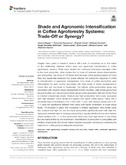| dc.contributor.author | Haggar, Jeremy | |
| dc.contributor.author | Casanoves, Fernando | |
| dc.contributor.author | Cerda, Rolando | |
| dc.contributor.author | Cerretelli, Stefania | |
| dc.contributor.author | Gonzalez-Mollinedo, Sergio | |
| dc.contributor.author | Lanza, Gracia | |
| dc.contributor.author | Lopez, Erick | |
| dc.contributor.author | Leiva, Benjamín | |
| dc.contributor.author | Ospina, Alejandra | |
| dc.date.accessioned | 2021-04-28T17:17:27Z | |
| dc.date.available | 2021-04-28T17:17:27Z | |
| dc.date.issued | 2021 | |
| dc.identifier.uri | https://repositorio.catie.ac.cr/handle/11554/10743 | |
| dc.description.abstract | Despite many years of research, there is still a lack of consensus as to the nature of the relationship between shade trees and agronomic intensification in coffee agroforestry systems. While some studies find unshaded intensively managed coffee is the most productive, other studies find no trade-off between shade characteristics and productivity. Our study of 179 farms from the main coffee growing regions of Costa Rica and Guatemala analyzed how shade affected the productive response of coffee to intensification of agronomic management. Four levels of coffee productivity were differentiated for each country associated with three levels of shade development in Costa Rica and two levels in Guatemala. The highest coffee productivity group was associated with medium shade development in both countries. High shade groups had low productivity, but very low productivity groups were associated with low (Costa Rica) or medium (Guatemala) shade. Medium and high productivity farms were associated with high elevation, lower rainfall and regions with higher coffee prices. Yields with a moderate level of investment (720–1,500 USD−1) and with medium shade (LAI 0.55- 1.1) were not significantly different from yields with higher investment or lower shade levels. The increase in yields with increasing N fertilizer application were similar under low, medium and high LAI, but the mean productivity significantly lower with high LAI. Agronomic intensification to increase productivity is equally effective for low and medium shade systems (LAI <1.1); low productivity farms may have high shade or low shade but are mainly limited by low investment... | es_ES |
| dc.language.iso | en | es_ES |
| dc.relation.ispartof | Frontiers in Sustainable Food Systems | es_ES |
| dc.rights | info:eu-repo/semantics/openAccess | es_ES |
| dc.subject | AGROFORESTERIA | es_ES |
| dc.subject | SERVICIOS ECOSISTEMICOS | es_ES |
| dc.subject | AREA FOLIAR | es_ES |
| dc.subject | CULTIVO BAJO SOMBRA | es_ES |
| dc.subject | CAFE | es_ES |
| dc.subject | AGRICUTURA SOSTENIBLE | es_ES |
| dc.subject | SISTEMAS AGROFORESTALES | es_ES |
| dc.subject | MANEJO AGRONOMICO | es_ES |
| dc.subject | PRODUCTIVIDAD | es_ES |
| dc.subject | CONSERVACION DE LA BIODIVERSIDAD | es_ES |
| dc.title | Shade and Agronomic Intensification in Coffee Agroforestry Systems: Trade-Off or Synergy? | es_ES |
| dc.type | Artículo | es_ES |


